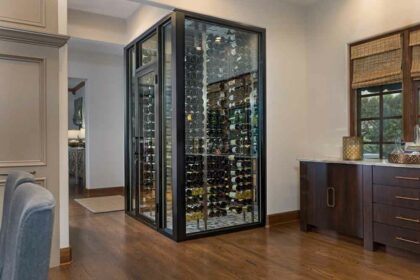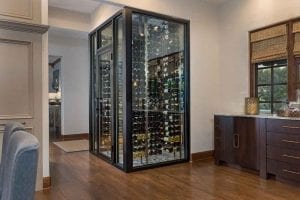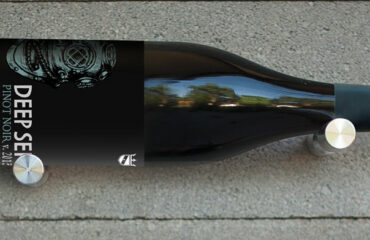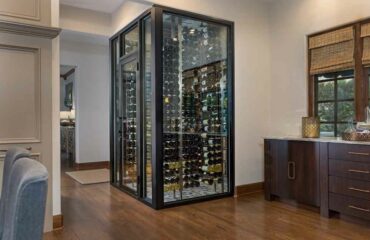What you need to know about wine cellar humidity whether you live in the sub-tropics of the south or the arid climates of the island

 You’ve taken the time to determine what type of cellar you need for your home and have landed on creating an active cellar that’ll keep wine safe for decades.
You’ve taken the time to determine what type of cellar you need for your home and have landed on creating an active cellar that’ll keep wine safe for decades.
What’s next? Let’s talk humidity. This plays a vital role in how you insulate the cellar, install a vapor barrier, and determine the cooling system needed.
Gary Chapdelaine of CRu Custom Wine Cellars and Saunas shares with us the basics for controlling humidity and what you need to know when installing a climate control system.
VintageView: What is the ideal temperature and humidity for a wine cellar?
Gary Chapdelaine: 60% is ideal, with a range of 50-70% adequate.
VV: How do you control humidity in a wine cellar?
GC: You can control humidity either actively (humidifier that adds humidity when needed), or passively (no humidifier needed). Passive control is only recommended when your wine room is in a tropical or semi-tropical, high-humidity environment. Florida has a constant 50-70% humidity, so I am able to simply recycle this humidity in the room or use a drip pan that catches water keeping it in the room. If properly sealed, humidity will stay constant. Arid climates (Arizona, northern states, etc.) have naturally lower humidity and do require humidifiers to maintain constant humidity levels.
VV: What is needed to install a vapor barrier?
GC: I recommend using closed-cell foam. A vapor barrier prevents oxygen from penetrating into the climate-controlled space. A wine room is a walk-in refrigerator, and like your home refrigerators, must be 100% sealed. Especially in sub-tropical climates like Florida. Arid climates can get away with some leakage, as mold spores do not grow well in arid climates. Here in Florida, rooms must be 100% sealed, or you will have problems too numerous to get into at this point.
In closed-cell foam, the foam cures to a solid state, and does not allow any oxygen to penetrate it. As the foam cures, it expands to fill all holes and gaps, creating the seal throughout the room. There is also open cell foam, but this should not be used as it allows oxygen to migrate through it. Free flowing oxygen plus 55 degrees plus cold equals a good breeding ground for black mold spores. Take the free flow of oxygen out of the equation and you remove this potential for mold.
Some builders chose to use Vizquine or other plastics to enclose their wine rooms. My problem with this is that you need to use either nails or staples to mount to the studs. By the very nature of this install, you are putting a hole in the vapor barrier and potentially allowing oxygen through the walls/ceiling.
VV: What is the difference between insulation and a vapor barrier? Does a cellar need both to moderate humidity?
GC: Yes, both are needed to control humidity. Insulation is a bridge that slows down the transference of heat into a room. The quick transference of heat can cause condensation. Think of taking a 42-degree soda out of the fridge and setting it down on the table in a 75 degrees room. Within a few minutes, water has formed on the outside from condensation. Use of insulation slows this down. Putting the drink in a Yeti or other insulated container prevents this quick transference and keeps drink colder for longer. Condensation is 100% humidity, so we don’t want that in a wine room, as that can cause water damage, or other problems. The vapor barrier keeps the air out….insulation slows down the transference of heat, keeping the room cold.
A climate-controlled wine room that has closed cell foam has both insulation and vapor barrier just by using that type of foam. Most closed cell foam has an approximate R-factor of 7 to 11 per inch of foam. The US Department of energy has tested these values, and actually places that number closer to 8 per inch of foam. The higher the R-factor, the better the insulation, and easier it is to maintain constant cool temperatures in a wine room. Two inches of foam is twice as effective as 1 inch. Five inches provides 5x the R-factor. More is better in a wine room.
VV: How do you ensure the flooring in a wine cellar will withstand the high humidity environment?
GC: Any hard material should be fine in a properly sealed/insulated wine room. It is only when you get very moist (85% or more humidity) that you create problems. If your room is properly built, you will not reach these humidity levels. If you do, you have an insulation/vapor barrier problem most likely.
Carpeting is really the only floor surface to avoid as it can trap moisture.
VV: In what kind of situation would you need to create humidity for a cellar? How would you do this?
GC: If you live in low humidity environments, you need to have a humidifier or some other method of adding humidity to reach proper levels. A spray bottle of water works as well. If your room is built properly, you will only lose humidity when you open the door. Keeping the room closed/sealed helps maintain constant humidity levels. You must go in and out of course, so use of a hygrometer (humidity sensor) will alert you to humidity levels and the need to add more.
More resources:
- 7 Important Considerations when Installing a Wine Cellar Cooling Unit
- Do you need cooling in the first place?
- 5 Tips to Storing Wine Safely for Years
Our offer is expanding and improving
VintageView.fr is now VinoRacking.com
Click to reach the equivalent of this page.



